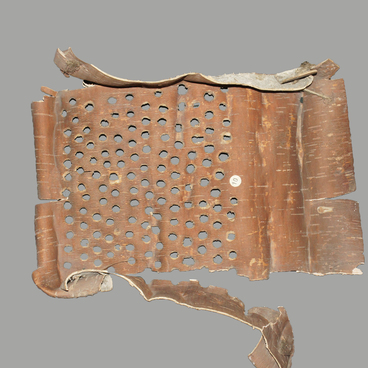Kunek is a traditional Bachat River Teleut women’s outfit used both as an everyday dress and a festal garment (additionally decorated with an embroidered breast plastron and a collar).
The dress (kunek in Teleutan) is a long tunic-cut shirt made of red silk fabric with a pressed flower design. On both sides, triangular gores rising to the armhole are sewn in. The sleeves are made of two pieces of fabric and tapered towards the hands. There are rhombic gussets of the same fabric. The shirt has a vertical mid-bosom slash. The stand collar, chaka, has a red cloth lining. Birch bark squares, akchas, resting on angles and densely embroidered with golden threads are sewn on the hem of the collar. The inside of the shirt is lined with coloured calico.
Teleuts are an aboriginal Turkic people in Russia, originating from the Turkic-speaking nomadic population of the southern part of Western Siberia. The Teleut population in Russia equals 2643 persons. Most of them, about 2 thousand, live in the villages of Bekovo, Chelukhoyevo, Verkhovskaya, Shanda, and Novobachaty in the Belovo and Guryevsk municipalities of the Kemerovo Oblast. These are so-called Bachat River Teleuts living along the rivers Bolshoi Bachat and Maly Bachat of the Ob river basin. Also, Teleuts live in the Novokuznetsk municipality of the Kemerovo Oblast and the Shebalino Municipality of the Republic of Altai.
Teleut as an ethnonym ascends to the Ancient Turkic ethnonym Tele. The history of the Tele can be traced back to the Early Middle Ages. In the 16th -18th centuries, Teleuts migrated from place to place in the Upper Ob region and the piedmont of Altai, on both sides of the Ob river. So, the land of the Teleuts included the bulk of the area between the river Irtysh in the west and the upstream and midstream river Tom in the east. Teleuts were semi-nomadic herdsmen who went in for appropriation forms of activities like hunting, fishing, and gathering. They practised farming, too, albeit primitive. By the 17th th century when Russians arrived in Siberia, the Teleuts had a well-shaped patriarchal-feudal system. They also had a dependent population, Kyshtyms.
The dress (kunek in Teleutan) is a long tunic-cut shirt made of red silk fabric with a pressed flower design. On both sides, triangular gores rising to the armhole are sewn in. The sleeves are made of two pieces of fabric and tapered towards the hands. There are rhombic gussets of the same fabric. The shirt has a vertical mid-bosom slash. The stand collar, chaka, has a red cloth lining. Birch bark squares, akchas, resting on angles and densely embroidered with golden threads are sewn on the hem of the collar. The inside of the shirt is lined with coloured calico.
Teleuts are an aboriginal Turkic people in Russia, originating from the Turkic-speaking nomadic population of the southern part of Western Siberia. The Teleut population in Russia equals 2643 persons. Most of them, about 2 thousand, live in the villages of Bekovo, Chelukhoyevo, Verkhovskaya, Shanda, and Novobachaty in the Belovo and Guryevsk municipalities of the Kemerovo Oblast. These are so-called Bachat River Teleuts living along the rivers Bolshoi Bachat and Maly Bachat of the Ob river basin. Also, Teleuts live in the Novokuznetsk municipality of the Kemerovo Oblast and the Shebalino Municipality of the Republic of Altai.
Teleut as an ethnonym ascends to the Ancient Turkic ethnonym Tele. The history of the Tele can be traced back to the Early Middle Ages. In the 16th -18th centuries, Teleuts migrated from place to place in the Upper Ob region and the piedmont of Altai, on both sides of the Ob river. So, the land of the Teleuts included the bulk of the area between the river Irtysh in the west and the upstream and midstream river Tom in the east. Teleuts were semi-nomadic herdsmen who went in for appropriation forms of activities like hunting, fishing, and gathering. They practised farming, too, albeit primitive. By the 17th th century when Russians arrived in Siberia, the Teleuts had a well-shaped patriarchal-feudal system. They also had a dependent population, Kyshtyms.

